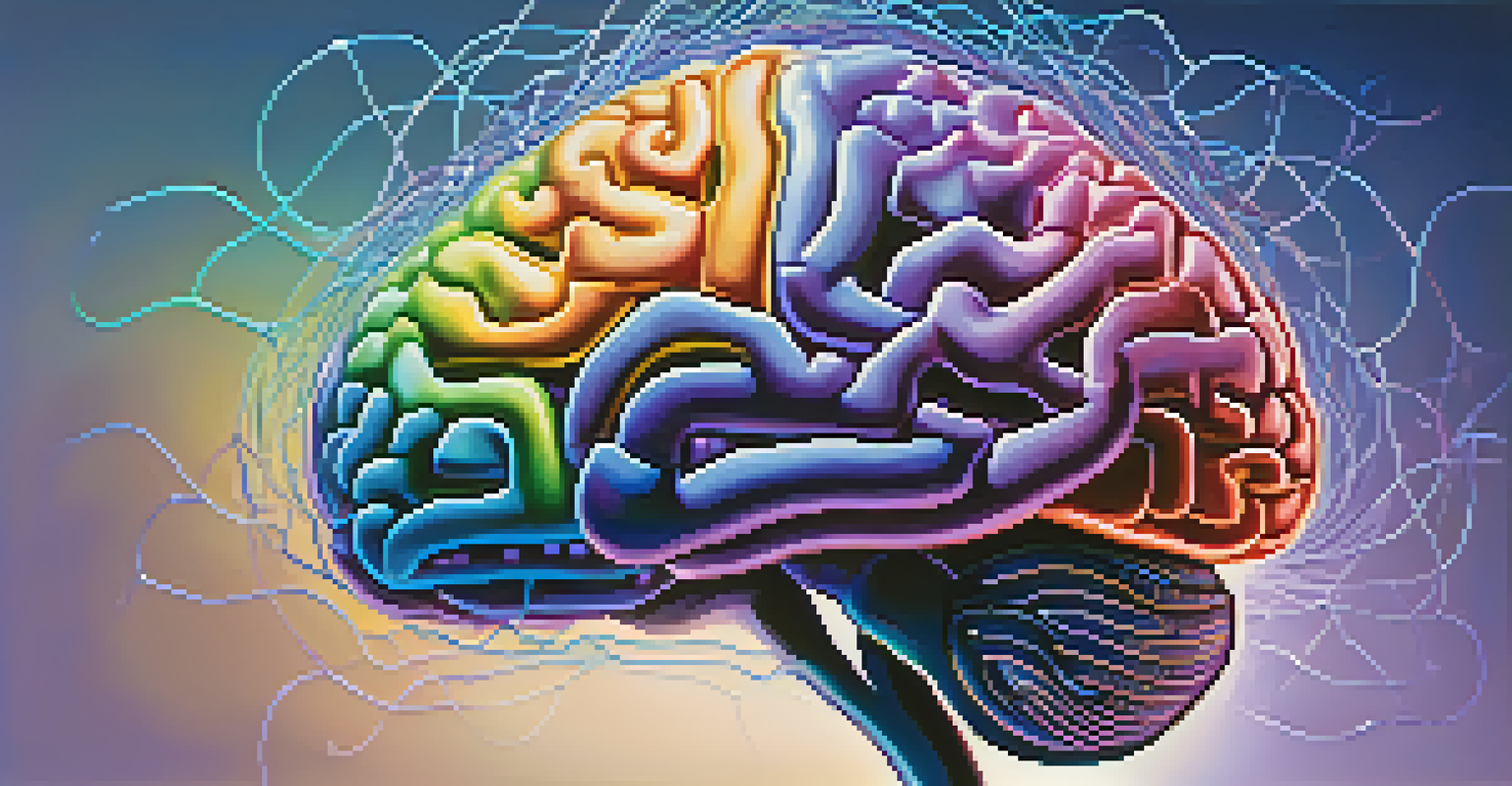Entheogens and Cognitive Behavioral Therapy: A Synergistic Approach

Understanding Entheogens: Nature's Psychedelic Tools
Entheogens are substances that have been used for centuries in various cultures for spiritual and therapeutic purposes. Common examples include psilocybin mushrooms and ayahuasca, both known for their mind-altering effects. These substances are believed to facilitate profound insights and emotional healing, making them a focal point in modern therapeutic practices.
The greatest discovery of my generation is that a human being can alter his life by altering his attitudes.
Recent studies have shown that entheogens can alter brain chemistry, enhancing neuroplasticity—the brain's ability to reorganize itself. This change can help individuals break free from entrenched thought patterns and emotional responses, a key goal in therapy. By understanding how entheogens affect the mind, we can better appreciate their potential in psychological treatments.
For many, the experience with entheogens can lead to deep personal revelations, fostering a sense of connection with oneself and the universe. This journey often serves as a catalyst for change, making it a powerful tool when combined with established therapeutic techniques like Cognitive Behavioral Therapy (CBT).
Cognitive Behavioral Therapy: A Framework for Change
Cognitive Behavioral Therapy is a widely used psychological treatment that focuses on identifying and altering negative thought patterns and behaviors. It operates on the principle that our thoughts influence our feelings, which in turn affect our actions. By addressing these connections, CBT aims to help individuals cultivate healthier mindsets and coping strategies.

During CBT, therapists guide clients to recognize distorted thinking and replace it with more balanced perspectives. This approach is particularly effective for treating anxiety, depression, and PTSD, as it empowers clients to take an active role in their mental health journey. The structured nature of CBT contrasts nicely with the often free-flowing experiences brought on by entheogens.
Entheogens Aid Emotional Healing
Entheogens, like psilocybin and ayahuasca, enhance neuroplasticity and facilitate profound insights, making them valuable in therapeutic contexts.
Combining CBT with entheogens can create a unique synergy, where the insights gained during altered states can be processed and integrated through structured therapy sessions. This partnership can lead to lasting change, as clients learn to apply newfound insights in their daily lives.
The Synergy: How Entheogens Enhance CBT Outcomes
Research indicates that when entheogens are used in conjunction with CBT, clients often experience deeper emotional breakthroughs. The heightened introspection provided by entheogens can reveal underlying issues that may not surface during traditional therapy alone. This allows therapists to tailor their approach to the individual more effectively.
The mind is everything. What you think, you become.
Moreover, the emotional openness and reduced anxiety experienced during entheogenic sessions can create a fertile ground for CBT techniques to take root. Clients often find it easier to challenge negative beliefs and explore difficult emotions when they are in a heightened state of awareness. This transformative process can foster resilience and promote lasting change.
Through this synergistic approach, clients may also develop a greater sense of trust in themselves and their therapists. The shared experience of exploring deep emotional landscapes can strengthen the therapeutic alliance, which is crucial for successful outcomes in any form of therapy.
Setting and Integration: Key Considerations
The setting in which entheogenic experiences take place is critical to their therapeutic effectiveness. Safe, controlled environments, often referred to as 'set and setting,' can significantly influence the outcomes of these experiences. Therapists play a vital role in creating a supportive atmosphere that encourages exploration and reflection.
After an entheogenic session, integration becomes essential. This process involves discussing and making sense of the experiences with a therapist to ensure that insights are grounded and actionable. Integration helps clients incorporate their revelations into their daily lives, reinforcing the benefits of both the entheogenic experience and CBT.
CBT Complements Entheogenic Insights
Combining Cognitive Behavioral Therapy with entheogens can lead to deeper emotional breakthroughs and more effective treatment outcomes.
Without proper integration, the profound insights gained during an entheogenic experience may fade or become overwhelming. Therapists can guide clients through this phase, helping them to navigate complex emotions and thoughts, ultimately leading to sustained personal growth and healing.
Challenges and Ethical Considerations in Therapy
While the combination of entheogens and CBT shows promise, it's not without challenges. Legal restrictions surrounding the use of these substances can hinder accessibility for those seeking this type of therapy. Additionally, mental health professionals must navigate the ethical implications of using entheogens, ensuring that clients are fully informed and consenting.
Therapists must also be trained in both CBT and the safe administration of entheogens to mitigate risks. Understanding the psychological effects and potential side effects is crucial for practitioners to provide effective care. This dual training can help create a framework that respects client safety while maximizing therapeutic benefits.
Furthermore, not all individuals may respond positively to entheogenic experiences. Personal history, mental health conditions, and individual preferences all play a role in determining whether this approach is suitable. Therefore, therapists must conduct thorough assessments to tailor their treatment plans accordingly.
The Future of Therapy: Bridging Science and Spirituality
As research into entheogens continues to evolve, the potential for integrating these substances into mainstream therapeutic practices grows. Studies are increasingly demonstrating their effectiveness in treating a range of mental health disorders, leading to a broader acceptance of their use in clinical settings. This shift represents a significant change in how we view mental health treatment.
The merging of science and spirituality through therapies that incorporate entheogens acknowledges the complexity of the human experience. It opens the door for a more holistic approach to mental health, where emotional, psychological, and spiritual dimensions are all considered. This comprehensive perspective can lead to more effective and personalized treatment plans.
Integration is Crucial for Success
Post-session integration with a therapist helps clients make sense of their entheogenic experiences, ensuring lasting personal growth.
As society becomes more open to exploring different avenues for healing, the collaboration between entheogens and CBT could pave the way for innovative practices that prioritize individual well-being. Ultimately, this could revolutionize how we approach mental health, fostering a more inclusive and compassionate understanding of human experience.
Conclusion: Embracing a New Therapeutic Paradigm
The integration of entheogens and Cognitive Behavioral Therapy presents an exciting frontier in mental health treatment. By combining the introspective power of entheogens with the structured approach of CBT, clients can achieve profound insights and lasting change. This synergy not only offers hope for those struggling with mental health issues but also challenges existing paradigms in therapy.
As we continue to explore this evolving landscape, it is essential to approach these methods with care, respect, and a commitment to ethical practices. The journey towards acceptance and understanding of entheogens in a therapeutic context is ongoing, but the potential benefits are undeniable.

Ultimately, embracing this new therapeutic paradigm could lead to more effective treatment options, fostering healing and growth for individuals seeking support. By bridging the gap between ancient wisdom and modern science, we can nurture a more comprehensive approach to mental well-being.